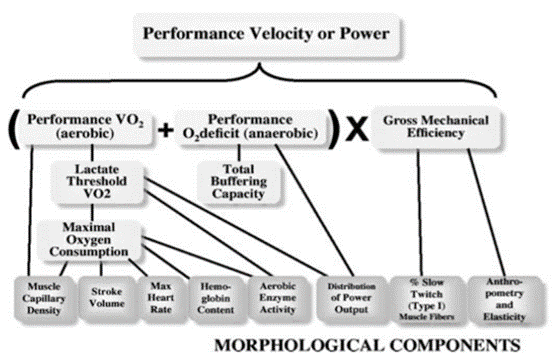If you are aiming for a faster time over the Ironman distance, if you want to reach the finish line more quickly at the next city run or simply if you want to keep up on the bike with your colleagues, you need to increase your endurance capacity. This article aims to clarify which parameters make up endurance performance, i.e. which parameters can be sensibly adjusted in order to increase it.
Endurance is commonly understood as the psychophysical resistance to fatigue. Endurance as the ability of the muscle cell to resynthesise ATP (adenosine triphosphate / energy supplier in the cells) consumed during exercise also directly influences an individual’s ability to recover. From a physiological point of view, the amount of power that can be delivered over a longer period of time is essentially dependent on the following three factors:
- the maximum oxygen uptake (VO2max)
- the maximum percentage of VO2max that can be maintained over a longer period of time – this is reflected by the performance, e.g. speed in running, at the anaerobic threshold. The anaerobic threshold in turn is determined by the VO2max and the lactate formation rate VLa.
- The anaerobic threshold is determined by the economy of movement – i.e. the energy required to achieve a given performance (Joyner & Coyle, 2008).

It should be noted at this point that explaining the final performance of an athlete goes far beyond a purely physiological consideration. A far more complex analysis is required for a full assessment. For example, motivational, sociological, etc. factors also contribute to the actual performance. For example, motivational, sociological, etc. factors also contribute to what performance can actually be shown.
Individual weighting and determination of the main factors
It is obvious that the importance of the individual factors for endurance performance depends to a large extent on the demand profile of the required load. For example, short competitions require a large maximum aerobic capacity (VO2max) with a high anaerobic capacity, while the submaximal determinants of endurance performance (lactate threshold, work economy) become more important with increasing distance. Furthermore, in sports or sub-disciplines in which tactical races and sprint decisions can occur, the anaerobic capacities are also decisive, whereas the lowest possible VLa is advantageous for long-term endurance exercise because it saves glycogen.
The individual characteristics of these factors are presented in an appropriate performance diagnostic. It is therefore advisable to carry out such a test at sensible intervals. Based on the conclusions drawn from this, the further training process can then be sensibly designed. INSCYD maps the relevant parameters with VO2max, VLa and movement economy.
Increasing endurance performance
Further blog posts will discuss what is behind these determinants of endurance performance from a physiological point of view, how they can be improved through training and which physiological mechanisms are behind them.
Here you find out more about why a metabolic profile is superior to a classic FTP test.
[1] Joyner, M.E. & Coyle, E.F. (2008). Endurance exercise performance: the physiology of champions. The Journal of Physiology, 586(1), 35-44.